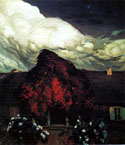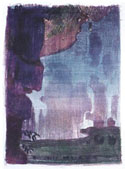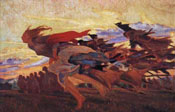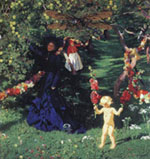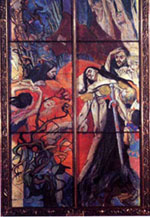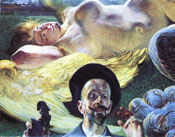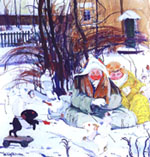The browser will either open the file, download it, or display a dialog.
| Jan Cavanaugh Out Looking In: Early Modern Polish Art, 1890–1918 Berkeley: University of California Press, 2000 xxiv, 307 pp.; 16 p. of plates (some color); $60.00 ISBN 0520211901 |
|||
| Despite its title, Jan Cavanaugh's book Out Looking In: Early Modern Polish Art, 1890–1918 does not offer any particular insight into the multifaceted character of Polish fin-de-siècle art so much as it presents, exhaustively, a thorough analysis of Sztuka ("Art"), the Society of Polish Artists founded in 1897 in Kraków, that undoubtedly fills a gap in the scholarship of Polish art at the turn of the century. | |||
| The author delivers convincing evidence that Sztuka, though an amalgamation of secession groups established in Berlin, Munich, and Vienna, formulated no aesthetic program of its own. The association gathered the most prominent Polish artists—coming from all three parts of partitioned Poland, though mainly from Kraków and Warsaw—in the initial phase of its existence. It embraced a variety of styles, diverse aesthetic predilections, and unrestrained subject matter choices, yet served mainly organizational goals, striving to uphold high artistic standards and to gain recognition for Polish art on the international arena. In doing so, it hoped to reunite the divided native country. Thus, the emphasis placed by Cavanaugh on Sztuka itself—its founding and evolution, changes within its inner structure, its participation in international exhibitions and interaction with foreign groups, a study extremely valuable in itself—does not, on its own, support her general conclusions about Polish modernism. Sztuka, in fact, did not epitomize all the essential properties of the modernist ideology. One of the reasons for such an overinterpretation is that the chronology of the group and the turning points of its activity are in no way identical to the development of Polish modernist art and aesthetics. For instance, Cavanaugh's focus on Sztuka fails to explain why the year 1890 serves as a beginning of the modernist period, even though this has been done in Polish literature by investigating the crystallization of the symbolist movement around this particular date. And she claims, without providing sufficient evidence, that the year 1908 marked a modification of the society's profile as well as a turning point in the history of Young Poland. Yet it was in 1910 that important changes in the overall character of Polish modernist art surfaced and the first signs of neoclassicism appeared to overshadow expressionism. Furthermore, despite the analysis of the large array of works executed by several members of Sztuka, it is insufficient to characterize Young Poland's artistic achievements comprehensively. Cavanaugh's research focused mainly on painting (but not exclusively; certain sculptures by Xawery Dunikowski, Boleslaw Biegas, Konstanty Laszczka, and Waclaw Szymanowski are included), and therefore is narrower in scope than the title of the book suggests. The study omits several disciplines: the applied arts, architecture, interior design, printmaking, and typography. Despite this shortcoming, Cavanaugh's attempt to incorporate Polish late-nineteenth- and early-twentieth-century culture into the European artistic scene is of unprecedented value. In order to explain the unique features of the Polish artistic milieu, Cavanaugh provides the reader with a broad historical context, and she examines crucial events in Poland's modern history against its European background and enlightens the specificity of Polish culture, shaped, as it was, by its fate with a politically subjugated nation. | |||
| Until the end of the seventeenth century, Poland had been a great European power. It was erased from the map of Europe in 1795 as a result of the third and final partition between Austria, Prussia, and Russia. The first partition occurred in 1772, when Stanislaus II ceded vast areas of his country to those nations; in 1793, Prussia and Russia instigated the second partition, and, after Kosciusko's unsuccessful uprising in 1794, Poland ceased to exist as an independent country until 1807, when Napoleon I established the duchy of Warsaw. Following Napoleon's collapse, the Congress of Vienna redrew the map of Europe, and Austria, Prussia, and Russia reestablished their authority over Polish lands. It was only in the aftermath of the First World War in 1918, with the simultaneous defeat of Germany and the collapse of the Austro-Hungarian empire and czarist Russia, that Poland regained its independence. Nevertheless, throughout the nineteenth century Poland had continued as an ethnic "nation," harboring a faith that it would reestablish its statehood and sovereignty. | |||
| Cavanaugh effectively demonstrates how Poland's complex political history and passion for independence dominated its nineteenth-century culture, which, in turn, determined the development of Polish art. She traces to Romanticism the focus on national identity in Polish art theory and criticism as well as the preoccupation with national iconography typical of Polish painting, thus revealing the genealogy of Young Poland's essentially neo-romantic ideology. Cavanaugh investigates how in the absence of a stable and independent political structure the patriotic ideology and pervasive national sentiment were embodied in the arts. For a nation in captivity, culture was the treasury of national memory, an enclave for the threatened national identity, and an essential tool in the long political struggle. Yet Cavanaugh also gives clear evidence that Polish art was deeply embedded in European culture. She provides a survey of the system of art education developed in Kraków and Warsaw, highlighting the importance of the continuation of the artists' studies in the cultural centers of Austria, France, Germany, Italy, and Russia. She uses her considerable expertise to connect the multiple interactions between Polish artistic circles and the artistic elites in Berlin, Munich, Paris, Saint Petersburg, and Vienna to the openness of the Polish art scene to new international trends, leading to its own modification and revitalization. | |||
| At the turn of the century, Polish culture reached a turning point. Cavanaugh's account clearly demonstrates that Polish fin-de-siècle art was not homogeneous in terms of its content and form, due in large part to the development of symbolism and expressionism alongside the centuries-old folk tradition and the decorative Art Nouveau style. The author explains how the role of the national iconographic tradition—exemplified in the patriotic cycles of Artur Grottger (1860s) and the historical paintings of Jan Matejko (1870s, 1880s)—was challenged in the late nineteenth century by innovative aesthetic theories and modernist aims. Cavanaugh refers to the battle for appreciation of purely aesthetic qualities and primacy of formal values over ideological ends fought in the 1880s by Stanislaw Witkiewicz, who, by arguing in favor of artistic autonomy, anticipated the concept of "pure art" expressed by modernist theoreticians in the 1900s. While discussing the philosophical and aesthetic stance of the most prominent art critics, Stanislaw Przybyszewski and Zenon Przesmycki-Miriam, Cavanaugh examines the roots of two distinctive currents within Polish modernism: early expressionism and symbolism. She emphasizes the critics' international connections: the Scandinavian and German literary movements as well as the expressionist tendencies in the visual arts (Edvard Munch, Gustav Vigeland), with which Przybyszewski was aligned, and French and Belgian symbolism, which Przesmycki advocated. She also spotlights a few collectors, especially Feliks Manggha-Jasienski, who were particularly enthusiastic about the assimilation of European and Japanese art into Polish culture. Foreign art was, however, on display at Polish galleries much more frequently than Cavanaugh presumes (for instance, at the well-known Aleksander Krywult Gallery in Warsaw). | |||
| Simultaneously, Cavanaugh underscores the "paradoxical nature of Polish modernism": an antagonism between two mainstreams, that is the "cultivation of national as well as international trends" (p. 211). She claims that "the confluence of contradictory aims—on the one hand, to resuscitate a hundred-year-old national tradition and, on the other, to keep pace with the onrush of international currents—gave a distinctive character to the art of the era" (p. 236). Assuming this interpretative stance, Cavanaugh presents a point of view contrary to Wieslaw Juszczak's classic, Malarstwo polskie: Modernizm (1972), the most fundamental thesis of Polish scholarship focused on the period of Young Poland. Juszczak maintains that inspiration drawn from European modernism, whether Belgian, French, or Scandinavian, was treated by Polish artists as a means for conveying patriotism and for creating a pictorial style expressive of native tradition. Often, especially in landscape painting and portraiture, the national issues were not conveyed explicitly or even allegorically, but nevertheless were integrated into purely formal qualities. Maria Poprzecka identified the period of Young Poland as "a happy hour" of Polish art, a perfect harmony and balance between foreign influences and the unique means of expression native to Polish culture. The best evidence for such a union might be Stanislaw Wyspianski's 1904–5 series of pastel drawings of the Kosciuszko Mound. These views can serve as the best example of the integration of impressionism into an expressionist landscape imbued with historical significance. The Kosciuszko Mound, recorded at different times of the day and in changing auras, does not resonate with color as does the facade of Monet's cathedral in Rouen. Rather, its fleeting luminous effects reflect the artist's own anxiety, for Kosciuszko Mound never loses its fundamental significance as a symbol of uprising and liberation, reflecting the hopes of the whole nation to regain independence in the course of the ongoing war between Russia and Japan. In Jacek Malczewski's unique symbolist iconography the theme of patriotic mission is also irrevocably interwoven with artistic motivation. | |||
| In addition to the historical iconography, a persistent awareness of the past in Polish fin-de-siècle art was also revealed in landscape imagery. The reification of the human being developed in the work of Wladyslaw Slewinski, Witold Wojtkiewicz, and Malczewski was an expression of extreme pessimism, whose broader context was the captive state of the Polish nation. Monumentalized and dramatized landscapes in modernist painting simultaneously symbolized history, nature's strength, and the universe. The persistent historical consciousness was conveyed by means of specific luminous effects and peculiar kinds of light infusing a somber color palette, and it resulted in a predominance of certain pictorial motifs, such as the misty aura of dawn to convey melancholy and the dispersed light of dusk to elicit anxiety. Polish modernists preferred the transitional phases of the seasons of the year—early spring and late autumn—and Cavanaugh rightly underscores the penchant of Polish painters for sad autumn evenings, nostalgic twilight hours, and uneasy cloudy nights, though she does not reveal the historical determinants of this tendency. | |||
| Though she presents a controversial understanding of the absorption of European influences, Cavanaugh avoids involvement in a polemic with Polish art historians, which might have yielded a very stimulating and fruitful discourse. Moreover, whereas she follows Juszczak's analysis concerning the distinction of two mainstreams, symbolism and early expressionism, she does not explain the philosophical premises of either worldview. The main goal of the symbolist aesthetics was to reveal the dual character of the reality, its physical and spiritual dimension. In investigating the world, the symbolists were penetrating the "spiritual essence of matter." The expressionists, on the other hand, used some personal poetics to create an individual, subjective pictorial world. In expressionism, reality was presented through the prism of the artist's psychological condition. It should be kept in mind, however, that in the context of Polish modernism both were essentially historical and both embraced a historical awareness. | |||
|
Cavanaugh also fails to explain the evolution of these two streams, from among which symbolism denotes the earliest, more moderate form of the new artistic experiments. Although she borrows from Juszczak's analyses the idea of a discontinuous pictorial space rendered by the symbolists, she avoids a thorough investigation of the aesthetic features unique to each current. Juszczak maintains that the difference between the symbolist and the expressionist styles of visualizing reality lies in their respective conceptions of pictorial space comprehended as a carrier of the work's most fundamental contents. Cavanaugh neither discusses Juszczak's theses nor presents explicitly her understanding of the different spatial formulae. She does, however, brilliantly analyze a broad array of modernist works. Some interpretations are indebted to Polish literature; others contribute considerably to the existing scholarship by offering an innovative, original approach. |
|||
| It is disconcerting, however, that while it aspires to offer a comprehensive presentation of Polish modern art, the book in fact includes a rather limited selection of artists, failing even to embrace all of the most outstanding members of Sztuka. Surprising indeed is the lack of careful attention paid to Leon Wyczólkowski, who, as a member of the Young Poland's pantheon, deserves to be placed alongside Jan Stanislawski, since both implemented original formulas for luminosity to be a bearer of symbolic content. Another issue is the classification of particular artists under the label of "symbolism" or "expressionism." Cavanaugh argues that in many cases the line between the two currents is unclear, which of course is true. Nevertheless, she changes the well-established categorization, for example by shifting Konrad Krzyzanowski, who is regarded as a highly original expressionist owing to the bold distortion of the external reality in his painting, into the domain of symbolism. And Stanislawski, who counts among the most outstanding symbolists, is presented as a sensitive, superb colorist. By stressing the emotive quality of the tonal gradations in his works, Cavanaugh overlooks the fact that Stanislawski's landscape paintings epitomize a pantheistic approach to nature and perfectly exemplify a search for the metaphysical essence of reality. In a monograph devoted to the artist (to which Cavanaugh makes only a brief reference), Juszczak investigates in depth the expressive means employed by the painter, who treats a solitary plant as a "figure" of the mood pervading a vast expanse of the landscape. Stanislawski thus turns a small extraction of nature into a self-enclosed, complete, and finite microcosm that faithfully reflects the rhythms of the universe. | |||
| Another odd classification is that of Wyspianski, whom Cavanaugh presents as a leading symbolist (with Malczewski) yet whose portraits, especially self-portraits, undoubtedly belong to the sphere of intensified expression. The author bases her categorization on Wyspianski's monumental works, the innovative patriotic iconography of which she thoroughly investigates; nevertheless, the stained-glass windows he designed for the Wawel cathedral are considered to be essentially expressionistic, owing to their pictorial qualities and spiritual power. The same applies to the portraiture of Olga Boznanska, which, according to Cavanaugh, falls into the category of symbolism. Yet, Boznanska's compositions exemplify a distorted, flattened pictorial space rendered by means of vibrant color patches peculiar to expressionism. | |||
| Another controversial aspect to Out Looking In is Cavanaugh's account of the output of particular artists, which proves to be too selective and limited. This is particularly striking in the case of Wyspianski, whose landscapes and portraiture are hardly mentioned, even though this part of the artist's oeuvre had a strong impact upon the younger generation of Polish modernists. Another important link missing from Cavanaugh's discourse is reference to the visionary compositions, most of them nocturnes, created by Józef Pankiewicz and Wladyslaw Podkowilski; these two artists briefly practiced the impressionist technique in the early 1890s only to abandon it in favor of a symbolist formula. It also would be difficult to agree with Cavanaugh's assumption that, while staying in Paris, Pankiewicz and Podkowinski assimilated simultaneously the impressionist method of capturing reality instantaneously and the evolution toward abstract imagery. Coming from provincial (when compared to Paris) Kraków, they simply were not prepared to harmoniously adopt two contradictory, at that point, artistic trends. | |||
| Nevertheless, there is much to commend here. The author accurately surveys the naturalist current derived from the Munich Stimmungsmalerei and supported in the Polish press by Stanislaw Witkiewicz. She convincingly proves that the fascination with light and color prevailing in the oeuvre of Aleksander Gierymski, one of the leading representatives of the naturalist movement, preceded the short-lived episode of Polish impressionism. And, she rightly emphasizes the condensed symbolism of nocturnes executed in abundance by Polish modernists, by maintaining that the artists eagerly exploited the monochromatic spectrum "to infuse their works with emotive, spiritual, or expressive content" (p. 118). Cavanaugh correctly addresses the issue of folk tradition comprehended by the modernists as a vital source of the national culture, and reveals the symbolic dimension of the depictions of the native land as well as the national overtones of the peasant imagery, representations of religious rituals, and the customs and activities typical of rural life. She offers sound evidence that the native land appeared to be, in fact, a true embodiment of Polishness. | |||
| Inexplicably, Cavanaugh downplays the role of the Group of Five, formed in 1905 to oppose the hegemony of symbolism epitomized in landscape painting. As she describes, Witold Wojtkiewicz, Mieczyslaw Jakimowicz, Vlastimil Hofmann, Leopold Gottlieb, and Jan Rembowski advocated the romantic idea of correspondence between visual arts and literature. However, their secessionist stance was symptomatic of a much broader phenomenon entangled in turn-of-the-century culture: a movement, led by the prominent writers Stanislaw Wyspianski, Stanislaw Brzozowski, Karol Irzykowski, and Waclaw Berent, which called for a reevaluation of the ideological principles of Young Poland and advocated abandoning the nostalgic, and passive, contemplation of Poland's past greatness in order to effectively change its future. Another symptom of the mounting dissatisfaction with well-established artistic concepts was a series of works—executed by artists of the younger generation—that were grotesque travesties and paraphrases of well-known paintings by the most prominent members of Sztuka. An album of lithographs issued in Kraków in 1905, for example, includes parodies of the works of Wyspianski, Mehoffer, Weiss, and Boznanska by Stanislaw Kuczborski, Stanislaw Rzecki, Karol Frycz, Kazimierz Sichulski, and Józef Czajkowski. | |||
| With the exception of the 101st exhibition in 1950—a show held at the Palace of Art in Kraków that embraced paintings rooted in the fin-de-siècle tradition of the society as well as works in line with the newly established doctrine of social realism—Sztuka ceased activities in 1937. Cavanaugh correctly states that in the interwar period Sztuka was "eclipsed by new groups born of a new era" (p. 75), yet she neglects to point out what part it played among the traditionalist and conservative artistic associations active on the new cultural scene. | |||
| One particularly notable aspect of Out Looking In is the dissemination of original names of Polish institutions, societies, groups, and periodicals, the majority of which Cavanaugh accurately delivers. | |||
| While arguing for Poland's place in the framework of European modernism, Out Looking In should be considered a groundbreaking publication in the field of cultural studies. The author's substantial expertise and knowledgeable discourse are complemented by an excellent selection of illustrations, a primary and rich source of visual material unknown in the West. The book undoubtedly opens new interpretative perspectives and serves as a firm foundation for a scholarly discussion and reevaluation of the multifaceted issues of European modernism in a milieu that few studies have explored. | |||
| Irena Kossowska Associate Professor, Institute of Arts Polish Academy of Sciences and Letters, Warsaw irenakos@mercury.ci.uw.edu.pl |
|||


